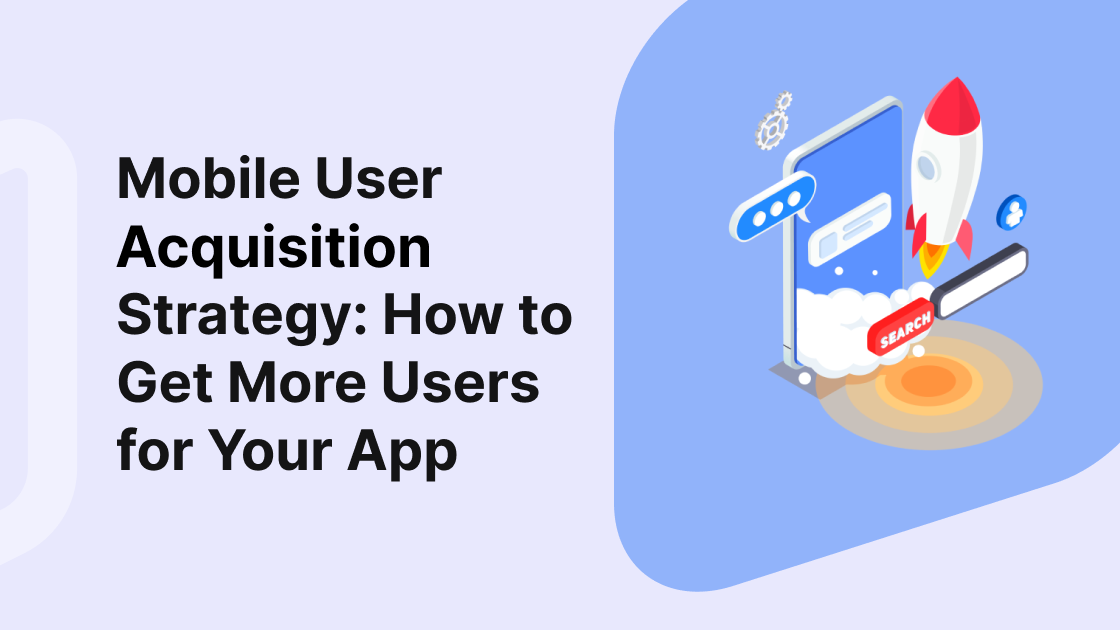Every mobile app needs a user acquisition strategy. The work doesn't stop once the app is live – now, you need people to use it.
User acquisition, or UA, is a strategy that's implemented to gain new users for an app. The goal of every UA is to increase downloads, but it's not all about the initial numbers – marketers need to seriously consider longevity to encourage long-term success.
Without a UA strategy, it becomes increasingly hard for marketers to target and convert new users. Competition amongst mobile apps is already fierce with close to 5 million available to download across the App Store and Google Play. So an effective UA strategy is key to keeping pace with and surpassing the competition.
To measure how effective a UA strategy is, marketers need to look at several metrics:
-
Cost per install (CPI) – this is the price to acquire a new customer from paid advertisements
-
Cost per acquisition (CPA) – this looks at the amount an advertiser spends to gain high-value users who take part in post-install activities
-
Return on Investment (ROI) – involves the returns you get from your app users – these returns come from purchases and other activities completed within the app
-
Cost per thousand (CPM) – sometimes referred to as ‘cost per mile’, this is the cost an advertiser pays per one thousand views or impressions of an advertisement
-
Customer acquisition cost (CAC) – this is achieved by dividing the cost of acquiring customers by the total number of customers acquired
How to get more users for your app
The two main ways of getting more users for your mobile app is organic or paid. Let’s take a look at what that means for each channel.
1. Acquiring users through organic marketing
App Store Optimization (ASO)
App store optimization is the process of increasing an app’s visibility in an app store in order to increase the number of organic app downloads. Apps are more visible when they rank highly on a wide variety of search terms, maintain a high position in the top charts, or get featured in the store.
Effective ASO also supports:
Other aspects to consider for ASO are app page and search page optimization. As you're pushing more people to your app store page, it’s a good idea to look at keywords and SEO best practices on that page, so your app appears at the top of the search list.
Website
The website for your app is a great organic marketing tool, it’s the number one source for app downloads, and it’s not all about the landing page either. Integrating a resource center into your app’s website provides a great hub for potential users to read all about your app, its benefits, wider industry trends, and thought leadership content. There's a whole host of mediums that this content can take the form of, from blogs and infographics to case studies and white papers.
Promoting this type of content for your app via channels such as social media then drives traffic back to your website. Don’t forget to ensure all content is SEO-optimized and includes clear CTA’s in order to encourage readers to download your app after reading.
Reviews & Ratings
We’re living in the review era, and users are placing more trust in the opinions of others. For potential users that find your app via an app store, reviews and ratings have a significant impact on whether they choose to download it or not. Reviews are a great way to directly address users’ feedback, questions, and concerns – it’s the best way to find out what users really think about your app and how you can improve things.
Marketers need to ensure they’re looking at things that include:
-
How many app ratings and reviews are there?
-
Are they positive?
-
If not, how can that be changed?
-
What is the overall score of the app?
Referrals
This is another great example of users trusting the opinions of other people that have already downloaded your mobile app. This time, we’re looking at referrals, where word of mouth helps to gain new users. Whether it’s a friend or family member or celebrity or influencer, referral marketing tactics can really help nudge potential users to convert.
Having the following incentives in place can help to keep a steady stream of new users coming in via referrals:
-
Offer something valuable in return for referrals, such as discounted or free In-App Purchases
-
Enable easy invite sharing on social media and chat apps
-
Reward power users for active participation
-
Ensure more value with every session
-
Make it a part of the user’s onboarding and in-app journey
Social media
Marketing your mobile app via organic social media is a free and effective way to get new users. It works especially well when combined with paid advertising social media tactics. Although organic reach has fallen dramatically for most platforms, it’s still important to have a presence there.
Marketers should look at the following:
-
What are the social media networks your target audience uses? Where do they live and what timezone are they in? What kind of content do they like (video, graphics)? Conducting research into these areas will better inform your UA strategy in this context, therefore making it much more likely to deliver positive results
-
Create engaging and quality content that will encourage everybody who comes to your app’s social media page to check out the app and download it
-
Post regularly to keep your app front of mind for your audience and to increase overall brand awareness. This also helps to maintain the community you’ve created around your app via its social presence
-
Run competitions to get users engaging with your brand and share your app’s social media profile to their followers, in return, offer prizes such as free in-app perks or discounts
Remember, this is a longer-term user acquisition strategy, so it can take time to start seeing results.
Content Marketing
While creating new content does come with a price tag – depending on if you’re using in-house resources or outsourcing – there are always free ways to market that content. Rather than just populating your website’s resource center with the content you’ve produced, such as blogs, infographics or videos, consider pushing them out via other methods like drip email marketing and social media, and online media outlets that are relevant to your app’s audience.
The content you create should be tailored specifically toward your target audience and their pain points, to which your app is the solution to. This helps to create a loyal following of targeted users, which you can then direct to your app product page and encourage them to download.
2. Acquiring users through paid advertising
According to a report released by Adjust and Zoomd Technologies in June 2022, the top paid channels for User Acquisition are:
Facebook
When used properly, Facebook is a great tool for marketers to leverage in order to target new users. Ads on the platform can specifically target users from a particular demographic, and more – it’s no wonder that the social media channel owns 31% of all mobile ad spend across devices.
There are two key ways to target new users via Facebook paid advertising:
-
App Event Optimization (AEO) – App Events allow your app or web page to track events, such as a person installing your app or completing a purchase. The function of an AEO campaign is to target new users who are most likely to perform specific actions within an app, such as completing a certain level or finishing the initial registration process – Facebook’s AI technology then optimizes ads for this specific purpose.
-
Value Optimization (VO): A Value Optimization (VO) campaign is an ad campaign that aims to find users who will get you the highest purchase value. It achieves this by telling Facebook to only target users it deems likely to reach a certain user-value figure – this figure is usually measured by the amount a user spends within the app. VO campaigns also leverage AI to reduce wasted ad spend.
These are two advertising methods that are very effective for mobile app marketers to utilize in order to target new users. However, it also makes it a pricey platform to use for this purpose. Competition for ad inventory is high so, the cost-per-install is always on the up.
Google
Google has an immense portfolio of platforms and tools available for developers to use to target new users.
-
Google Search: this is a big one – remember, Google is the most-used search engine worldwide. Marketers can leverage this by adopting SEO best practices and creating AdWords campaigns, meaning you can get your app in front of a vast number of your target audience.
-
The Google Play Store: Google has 2.87 million unique apps in its library, which is almost one million more than the Apple App Store has – use it! Target audiences can be reached on Google Play via organic search and through Universal App Campaigns (UAC). UAC is an automated ad type in Google Ads that helps advertisers generate more app installs and/or drive in-app conversions. The technique uses machine learning to identify best-performing ads and shows them to the most relevant users.
-
YouTube: the video platform has over 122 million active users daily. This means that sharing videos and ads on the platform can help market your app to millions of potential users. YouTube ads tend to drive higher brand awareness as they work more like traditional TV ads than direct response ads, like those that are used for social media for example.
-
Google Display Network: this tool enables app developers to display ads on more than 2 million different websites and reach 90% of internet users around the world. Developing an eye-catching ad that links to your app’s product page can help drive a lot of targeted traffic and encourage downloads.
-
Google Discover Ads: these ads are shown to 800 million Google Discover users, which is a customizable feed that Google’s AI technology automatically populates with news items and stories of interest. By creating Discovery ads, you can reach millions of new users with your app.
Google also boasts an impressive percentage of ownership for total mobile ad spending across devices, at 33% – providing an ideal platform to target new users. The only challenge with using the Google portfolio for this is that analytics can be lacking, so it can be hard to trace where and when new users have converted.
Mobile ad networks
Mobile ad networks are platforms where app developers, or ‘publishers’ in this context, can sell ad space, and marketers or ‘advertisers’ can then buy that ad space. This advertising method works effectively for both UA, as advertisers can buy up space, and app monetization, as developers can sell space. These types of ads are often displayed via banners and videos.
Some of the most popular and most successful mobile ad networks to boost mobile app user acquisition include:
-
Vungle: one of the key advantages of Vungle is that the network has a creative team that will help you develop ads that convert and includes tracking features so you always know how your ads are performing, enabling you to adjust according to results.
-
Unity: this is one of the largest gaming ad networks in the world, boasting an impressive 1billion+ mobile gamers, allowing those seeking increased UA to tap into a large inventory of in-game ads. Unity announced in July 2022 its merger with ironSource, a leading business platform for the App Economy that acquired Tapjoy in 2021.
-
AdColony: AdColony is trusted by more than 85% of the top-grossing app developers. Like Vungle, the company has an in-house creative team that will support and even design ads for you and they also deliver app-level transparency so you always know where and how your campaigns are being delivered
Of course, there are many other mobile ad networks that can be leveraged to increase user acquisition, such as Start.io, Applovin, and MoPub, the former Twitter subsidiary that was recently acquired by Applovin.
Apple Search Ads
The Apple App Store has space specifically dedicated to ads, and advertisers can bid on those ad spaces and gain significant traffic from them. However, Search Ads are different from conventional ads – in fact, they’re not technically ads in this sense like the pop-ups or banners you see. Instead, it’s all about app placement – they put your app in the top spot of a search result for a given keyword. This means that you’re almost guaranteed to acquire the most traffic for that particular keyword for as long as the ad is active.
You would think that this incurs some hefty upfront ad spend, but no. The platform operates on a CPT (cost-per-tap) basis so, your funds will only be deducted once a user taps on your app’s ad.
Read our article to know how to use Apple Search Ads to complement your subscription campaigns.
TikTok
According to the report released by Adjust and Zoomd Technologies, 30% of app marketers are already using TikTok as a paid acquisition channel.
As the platform is at the crossroads of influencer marketing and paid advertising, an app publisher may leverage on several marketing opportunities:
Some great examples are:
Mobile user acquisition strategies: The key takeaways
So, there you have it, a whole host of methods for a successful user acquisition strategy for your mobile app, whether you have the budget to spend on paid advertising or not. Please listen to our podcast episode with Ania Wyzocka, Founder of Rootd, to get a concrete user acquisition strategy with a proven track record: How to bootstrap the #1 health and fitness app.
Here are our key takeaways:
-
If you want new users, you need to have a UA strategy in place
-
Be agile and ready to adapt your strategy based on changing trends
-
If you don’t have the budget, don’t worry, there are organic options
-
Ads on social media and video platforms have a huge impact
-
Make sure you research where and what channels your audience uses
Optimize your Subscriber Acquisition Strategy with Purchasely
If you’re an app marketer or developer that’s looking to improve your conversion rates (install to trial CVR, trial to paid CVR), Purchasely’s industry-leading paywall builder will help you to learn what converts the best!
Book a 30-minute product tour with one of our experts where they’ll talk you through the most intuitive no-code paywall builder and how it can help you increase subscriber acquisition strategy.
.png)
.png)



